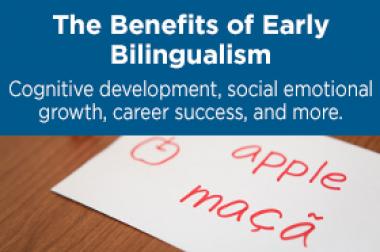
Who wouldn’t want a more flexible brain? How about greater focus? A better memory? Stronger relationships with extended family?
Individuals who are bilingual (speaking two or more languages) and biliterate (speaking, writing, and reading in two or more languages) have more active brains, and there are distinct, long-term benefits into adulthood.
Bilingualism also supports social-emotional health by improving communication and relationship-building skills.
Extra flexibility for problem-solving skills and other cognitive benefits

When you learn how to switch between languages at a young age, you develop more flexible approaches to thinking that can pay dividends throughout life. Flexible approaches help students and workers solve complex problems.
The research proves it. Bilingual infants and toddlers enjoy cognitive advantages, including in certain aspects of memory, such as generalizing information from one event to a later event.
(Adults, you can still get the benefits of bilingualism. Just ask Mark Zuckerberg, Sergey Brin, Marissa Mayer, and other business leaders.)
Meaningful connections mean the world to children and families

The ability to understand one another and communicate effectively are the building blocks of supportive, affirming relationships.
Research shows that bilingual preschoolers are better able to understand others’ perspectives, thoughts, and intentions, and are more sensitive to tone of voice and other aspects of communication. This empowers relationship-building.
In families where multiple languages are spoken, bilingualism helps young ones develop a sense of identity, thanks to stronger connections with relatives. And having a sense of identity is linked to greater self-confidence and more. The same holds true for friendships in an increasingly diverse society.
Academic and career success for bilingual individuals
The U.S. job market is a feast of opportunity for bilingual individuals, as many roles require fluency in more than one language. Bilingualism can also benefit career growth long-term, thanks to a variety of skills, including:
1. Higher levels of abstract thought for creative problem-solving.
2. Improved focus, since bilingual individuals are better at blocking out irrelevant information.
3. Executive functioning improvements, such as self-control, a key indicator of school and workplace success.
How to encourage bilingualism and cultural fluency
It’s never too early to introduce children to multiple languages.
Bilingual parents are encouraged to speak both their native and adopted languages at home. Reading is also a powerful tool for multilingual and monolingual households alike. Check out the Worcester Public Library and local booksellers like Starbright Books and TidePool BookShop for bilingual children’s books and books in a variety of languages.
Families can also seek out preschool immersion programs, where bilingualism is a focus, and childcare programs where early educators speak multiple languages.
Of course, language is just one aspect of culture. Parents can also share music, foods, and other cultural experiences with young ones.
Make learning fun and children are sure to follow!
